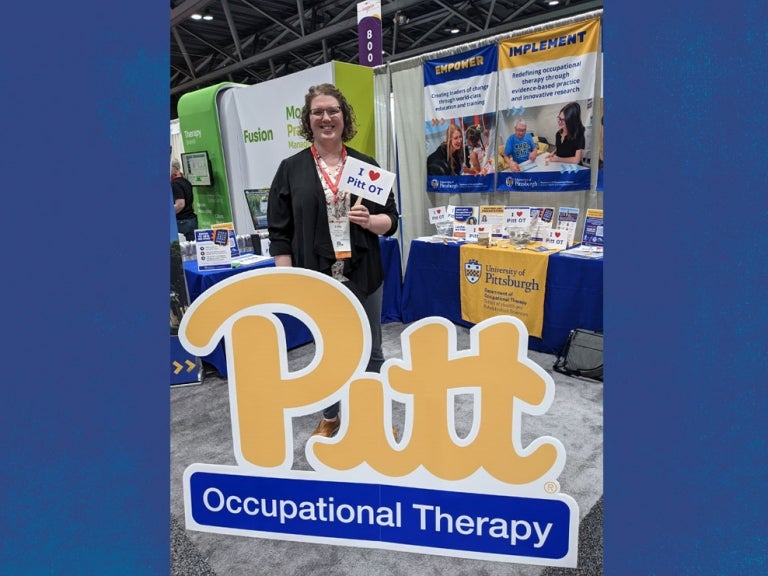
Emily Haffner at the School of Health and Rehabilitation Sciences OT booth at AOTA 2023
When I started looking for post-professional occupational therapy (OT) degree programs, I wanted to make sure the one I selected would help me gain skills to advance my career, but I was also worried about the online learning environment that many of them offered. Would I still be able to build relationships with my classmates and faculty? Would I be able to learn as well in the virtual environment? By the end of my first semester in the University of Pittsburgh Doctor of Clinical Science (CScD) in Occupational Therapy online program, I could unequivocally say that I had selected an amazing program both for the content I was learning and the methods used to facilitate that learning.
When my friends and co-workers ask me about the Pitt CScD online program they are sometimes surprised to hear me describe it as enjoyable, engaging and energizing. I describe how I can focus the class assignments on areas of OT practice that interest me. I talk about the rich conversations I have with my classmates each week applying the information to different areas of occupational therapy practice across the country. I speak of the faculty who are so supportive and able to provide mentorship throughout the program.
I have been able to apply the new knowledge directly to my everyday work in a number of ways. One of the most exciting opportunities I had was taking an assignment for class and actually putting it to use in my workplace. The assignment was focused on identifying an opportunity and developing a plan to create a change in practice.
At the time, I was working in an outpatient setting for adults with neurological conditions and the opportunity was to reduce the wait time for our patients to be seen for their initial evaluation. The clinic had tried several strategies in the past to reduce the waitlist, but it had continued to grow. I found an evidence-based solution in the literature and applied an implementation framework learned in class to create the plan. I worked with my manager and co-workers to form a committee and implement the change in our clinic. The project was more successful than anything we had tried in the past. The wait to get an OT or speech evaluation went from four weeks to on-demand, and the wait for a physical therapy evaluation went from 12 weeks to four.
I think the project’s success was, in part, due to the fact that I used an implementation model and other strategies I learned from the CScD program. The solution to the waitlist problem did not require additional space, staff, time or funding. We were able to make the change in our practice using a multiple-solution approach with the resources we already had. One of the solutions was created after the therapists stated they felt uncomfortable discharging patients with chronic neurological conditions because the patients would often stop their exercises once they stopped therapy and then return in a few months with a decline in symptoms from limited activity. The committee identified several options for accessible fitness options in the community and created tools for therapists to help teach patients how to access these community resources. The therapists and the patients felt more comfortable with discharging, and this allowed for other patients to be seen in the clinic and receive the services they need. These small changes, implemented with the right type of support and tools, led to a reduction in the clinic’s waitlist that has been sustained for the last two years.
After sharing this success with CScD Program Director Pam Toto, she encouraged me to submit the project as a presentation at local and national conferences. Completing the presentation at my state OT conference and the American Occupational Therapy Association (AOTA) conference was a rewarding experience and a reminder of just how much knowledge I have gained from the CScD program. The therapists who attended my presentations were interested in both the evidence I used to address the waitlist and the implementation strategies and model I used to make the change. It was exciting to share this cutting-edge information with other OT practitioners and see a spark in their eyes–-motivated to take knowledge back home and try it out. While most of the attendees did not necessarily have a waitlist problem, they did see other areas of opportunity in their workplaces and felt they could use the implementation model to help improve their practice settings.
If not for the support of the faculty and the skills and knowledge I have gained in the Pitt CScD program, I don’t think I would be making these changes in my career. I am a little sad to know that I am finishing my degree this year because I will miss the dynamic conversations in class, but I know I have the continued support of the Pitt community and some of the time that was used for classes can be used for new opportunities in my career!
-----------
Written by Emily Haffner (CScD ‘24). She is the team lead for the Driving Rehabilitation Program at The Ohio State University in Columbus, Ohio.
---
Published June 21, 2023
